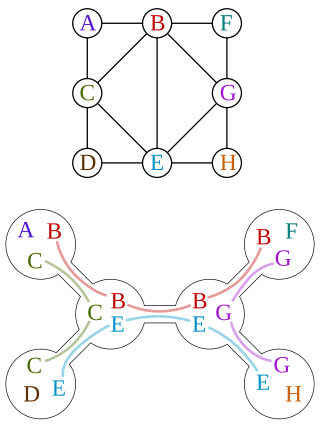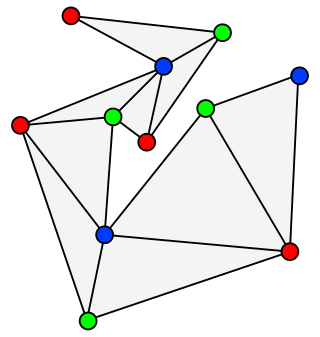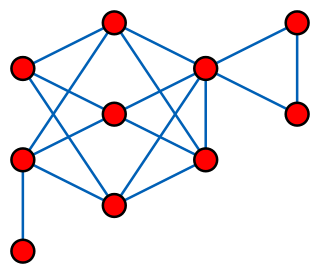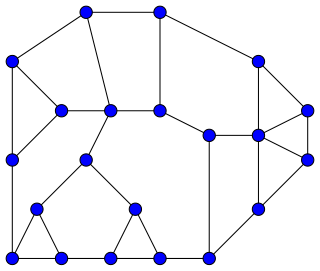Related Research Articles

In graph theory, a tree decomposition is a mapping of a graph into a tree that can be used to define the treewidth of the graph and speed up solving certain computational problems on the graph.

In graph theory, an outerplanar graph is a graph that has a planar drawing for which all vertices belong to the outer face of the drawing.

In graph theory, a complete coloring is a vertex coloring in which every pair of colors appears on at least one pair of adjacent vertices. Equivalently, a complete coloring is minimal in the sense that it cannot be transformed into a proper coloring with fewer colors by merging pairs of color classes. The achromatic numberψ(G) of a graph G is the maximum number of colors possible in any complete coloring of G.

In the mathematical area of graph theory, a chordal graph is one in which all cycles of four or more vertices have a chord, which is an edge that is not part of the cycle but connects two vertices of the cycle. Equivalently, every induced cycle in the graph should have exactly three vertices. The chordal graphs may also be characterized as the graphs that have perfect elimination orderings, as the graphs in which each minimal separator is a clique, and as the intersection graphs of subtrees of a tree. They are sometimes also called rigid circuit graphs or triangulated graphs.

In graph theory, a cograph, or complement-reducible graph, or P4-free graph, is a graph that can be generated from the single-vertex graph K1 by complementation and disjoint union. That is, the family of cographs is the smallest class of graphs that includes K1 and is closed under complementation and disjoint union.

In graph theory, a circle graph is the intersection graph of a chord diagram. That is, it is an undirected graph whose vertices can be associated with a finite system of chords of a circle such that two vertices are adjacent if and only if the corresponding chords cross each other.
In graph theory, the metric dimension of a graph G is the minimum cardinality of a subset S of vertices such that all other vertices are uniquely determined by their distances to the vertices in S. Finding the metric dimension of a graph is an NP-hard problem; the decision version, determining whether the metric dimension is less than a given value, is NP-complete.
The graph isomorphism problem is the computational problem of determining whether two finite graphs are isomorphic.
A tree k-spanner of a graph is a spanning subtree of in which the distance between every pair of vertices is at most times their distance in .
In graph theory, the treewidth of an undirected graph is an integer number which specifies, informally, how far the graph is from being a tree. The smallest treewidth is 1; the graphs with treewidth 1 are exactly the trees and the forests. The graphs with treewidth at most 2 are the series–parallel graphs. The maximal graphs with treewidth exactly k are called k-trees, and the graphs with treewidth at most k are called partial k-trees. Many other well-studied graph families also have bounded treewidth.
In graph theory, a path decomposition of a graph G is, informally, a representation of G as a "thickened" path graph, and the pathwidth of G is a number that measures how much the path was thickened to form G. More formally, a path-decomposition is a sequence of subsets of vertices of G such that the endpoints of each edge appear in one of the subsets and such that each vertex appears in a contiguous subsequence of the subsets, and the pathwidth is one less than the size of the largest set in such a decomposition. Pathwidth is also known as interval thickness, vertex separation number, or node searching number.

In graph theory, series–parallel graphs are graphs with two distinguished vertices called terminals, formed recursively by two simple composition operations. They can be used to model series and parallel electric circuits.

In graph theory, the clique-width of a graph G is a parameter that describes the structural complexity of the graph; it is closely related to treewidth, but unlike treewidth it can be small for dense graphs. It is defined as the minimum number of labels needed to construct G by means of the following 4 operations :
- Creation of a new vertex v with label i (denoted by i(v))
- Disjoint union of two labeled graphs G and H (denoted by )
- Joining by an edge every vertex labeled i to every vertex labeled j (denoted by η(i,j)), where i ≠ j
- Renaming label i to label j (denoted by ρ(i,j))

In graph theory, a branch of discrete mathematics, a distance-hereditary graph is a graph in which the distances in any connected induced subgraph are the same as they are in the original graph. Thus, any induced subgraph inherits the distances of the larger graph.

In the mathematical field of graph theory, a permutation graph is a graph whose vertices represent the elements of a permutation, and whose edges represent pairs of elements that are reversed by the permutation. Permutation graphs may also be defined geometrically, as the intersection graphs of line segments whose endpoints lie on two parallel lines. Different permutations may give rise to the same permutation graph; a given graph has a unique representation if it is prime with respect to the modular decomposition.

In graph theory, a Halin graph is a type of planar graph, constructed by connecting the leaves of a tree into a cycle. The tree must have at least four vertices, none of which has exactly two neighbors; it should be drawn in the plane so none of its edges cross, and the cycle connects the leaves in their clockwise ordering in this embedding. Thus, the cycle forms the outer face of the Halin graph, with the tree inside it.
In computer science, lexicographic breadth-first search or Lex-BFS is a linear time algorithm for ordering the vertices of a graph. The algorithm is different from a breadth-first search, but it produces an ordering that is consistent with breadth-first search.
In graph theory, a branch of mathematics, a chordal completion of a given undirected graph G is a chordal graph, on the same vertex set, that has G as a subgraph. A minimal chordal completion is a chordal completion such that any graph formed by removing an edge would no longer be a chordal completion. A minimum chordal completion is a chordal completion with as few edges as possible.
Lorna Kay Stewart is a retired Canadian computer scientist and discrete mathematician whose research concerns algorithms in graph theory and special classes of graphs, including cographs, permutation graphs, interval graphs, comparability graphs and their complements, well-covered graphs, and asteroidal triple-free graphs. She earned her Ph.D. in 1985 at the University of Toronto under the supervision of Derek Corneil, and is a professor emerita at the University of Alberta.
References
- ↑ "Derek Corneil: Renowned and Esteemed Computer Science Professor Emeritus University of Toronto - Canadian IT Manager's Blog - Site Home - TechNet Blogs". Archived from the original on 2011-06-23. Retrieved 2012-02-19.
- 1 2 Biography, University of Toronto. Retrieved 1/8 February 2012.
- ↑ Derek Gordon Corneil at the Mathematics Genealogy Project
- ↑ "Derek Corneil: Retiring after 40 years with DCS" (PDF), @DCS, University of Toronto Department of Computer Science, 1 (3): 8, 2010.
- ↑ Arnborg, Stefan; Corneil, Derek G.; Proskurowski, Andrzej (1987), "Complexity of finding embeddings in a $k$-tree", SIAM Journal on Algebraic and Discrete Methods, 8 (2): 277–284, doi:10.1137/0608024, MR 0881187 .
- ↑ Corneil, D. G.; Lerchs, H.; Burlingham, L. Stewart (1981), "Complement reducible graphs", Discrete Applied Mathematics , 3 (3): 163–174, doi:10.1016/0166-218X(81)90013-5, MR 0619603
- ↑ Corneil, D. G.; Perl, Y.; Stewart, L. K. (1985), "A linear recognition algorithm for cographs", SIAM Journal on Computing, 14 (4): 926–934, doi:10.1137/0214065, MR 0807891 .
- ↑ Corneil, D. G.; Gotlieb, C. C. (1970), "An efficient algorithm for graph isomorphism", Journal of the ACM , 17: 51–64, CiteSeerX 10.1.1.453.3730 , doi:10.1145/321556.321562, MR 0278977, S2CID 207720001
- ↑ Read, Ronald C.; Corneil, Derek G. (1977), "The graph isomorphism disease", Journal of Graph Theory , 1 (4): 339–363, doi:10.1002/jgt.3190010410, MR 0485586 .
- ↑ Corneil, D.G.; Lerchs, H.; Burlingham, L.Stewart (1981). "Complement reducible graphs". Discrete Applied Mathematics. 3 (3): 163–174. doi:10.1016/0166-218X(81)90013-5.
- ↑ Corneil, Derek G.; Olariu, Stephan; Stewart, Lorna (1997). "Asteroidal Triple-Free Graphs". SIAM Journal on Discrete Mathematics. 10 (3): 399–430. doi:10.1137/S0895480193250125.
- ↑ Arnborg, Stefan; Corneil, Derek G.; Proskurowski, Andrzej (1987). "Complexity of Finding Embeddings in a k -Tree". SIAM Journal on Algebraic and Discrete Methods. 8 (2): 277–284. doi:10.1137/0608024.
- ↑ Cai, Leizhen; Corneil, Derek G. (1995). "Tree Spanners". SIAM Journal on Discrete Mathematics. 8 (3): 359–387. doi:10.1137/S0895480192237403.
- ↑ Corneil, Derek G.; Rotics, Udi (2005). "On the Relationship Between Clique-Width and Treewidth". SIAM Journal on Computing. 34 (4): 825–847. doi:10.1137/S0097539701385351.
- ↑ Corneil, Derek G.; Dragan, Feodor F.; Habib, Michel; Paul, Christophe (2001). "Diameter determination on restricted graph families" (PDF). Discrete Applied Mathematics. 113 (2–3): 143–166. doi:10.1016/S0166-218X(00)00281-X.
- ↑ Mertzios, George B.; Corneil, Derek G. (2011). "Vertex splitting and the recognition of trapezoid graphs" (PDF). Discrete Applied Mathematics. 159 (11): 1131–1147. doi:10.1016/j.dam.2011.03.023.
- ↑ Fields Institute Fellows. Retrieved 18 February 2012.